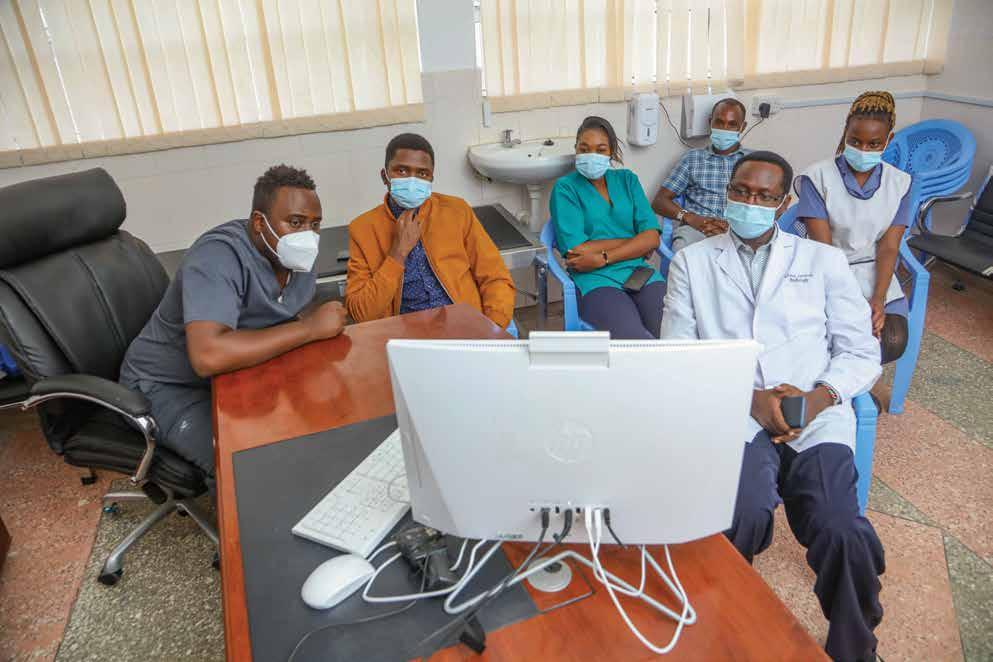
4 minute read
Telemedicine Project
FEATURE
Daktari Smart Telemedicine Program
Advertisement
Gertrude’s Children’s Hospital, in partnership with M-PESA Foundation, Safaricom PLC, Gertrude’s Hospital Foundation and the County Governments of Samburu, Baringo, Lamu and Homabay, have partnered to improve access to quality specialist care to children in these counties by leveraging on the use of technology.
The introduction and use of Telemedicine is aimed at reducing the number of referrals of sick children and optimizing the capacity and reach of healthcare delivery systems by allowing level IV and V hospitals have access to specialists. During the first phase, the project will provide free specialist care and treatment to 32,400 children in six counties. In addition, the telemedicine platform will be used to improve the capacity of 300 health workers to correctly diagnose and treat sick children, as well as correctly link children who require advanced/ specialized care.
Gertrude’s Hospital Foundation’s mission is to provide the best available healthcare services to needy and disadvantaged children in Kenya through the integration of care, research, education, and technology. This program aligns with our mission to leverage technology and innovative approaches to effectively diagnose and treat needy children irrespective of their geographical location in the country.
The telemedicine platform is a Health Presence Communication Equipment which comprises of electronic medical devices such as the electronic stethoscope, vital signs monitor, dermascope camera, ultrasound machine, otoscope, and ECG (electrocardiogram). Different from the conventional video conferencing, the telemedicine platform allows the health worker at the local partner health facilities to place the probes on the patient and the specialist at Gertrude’s Children’s Hospital can see the patient and hear the sounds real time without interpretation from the health worker at the local facility. The bandwidth requirement for the equipment is low, ranging from 512Kbps to 2Mbps. This means that the platform can be installed in rural and underserved areas that do not have fibre connectivity.
Joan Lekalderu, a Samburu County resident, (R) and her son Emmanuel use Telemedicine consultation services provided by Pateti Kelvin Lengees, a doctor at Samburu County Referral Hospital, in consultation with a paediatric doctor from Gertrude's Children’s Hospital
Health workers from Samburu County Referral Hospital, taking part in a virtual training session in Telemedicine.

The Gertrude’s TeleAfya program implemented telemedicine in Daadab Level IV Hospital in Garissa County, Sekenani Health Centre in Narok County, and the Gertrude’s Mombasa Clinic in Mombasa County. Between 2016 and 2017, the platform was used to attend to over 250 referral cases and train 90 community health workers in Sekenani and Daadab to help in patient follow up after clinic appointments. The referred cases mainly comprised of communicable diseases like pneumonia and tuberculosis, developmental disorders such as cerebral palsy, vitamin deficiency disorders such as rickets, allergic conditions such as asthma and non-communicable diseases such as diabetes and cancer.
Telemedicine practical training has not been widely included into medical, nursing, or continuing education curriculum, resulting in provider confusion and doubt. Healthcare professionals are under pressure to offer high quality care while also considering patient expectations for outcomes and satisfaction metrics as they operate in a new care medium. It's not as straightforward as conducting a traditional office visit over the phone or through webcam to provide virtual care. Providers in a clinic setting have specialised resources at their disposal to assess patients, such as physical exam data, point-of-care testing, and complete access to current medical records.
When creating the telemedicine training program, it's crucial to break down the components of an in-person visit to understand what data is available to a physician in a traditional clinic and determine when and if that same information could be acquired in a virtual visit, piece by piece. When it comes to telemedicine, the major focus should be on patient safety rather than number of patients treated.
Existing clinical practice recommendations, as well as primary source data, must be reviewed and applied to the context of telemedicine. This assists clinicians in determining which patients, symptoms, and diseases are suitable for telemedicine and when patients should be referred for in-person evaluation. Of course, each patient is different and must be treated as such, but healthcare staff must never put a patient at risk by presuming they have enough data to make a diagnosis when they don't. Telemedicine connects rural and isolated places with healthcare professionals all over the world by opening up new communication channels, overcoming geographical barriers and seeking to counteract the 'brain drain' or flight of human capital. This may result in improved communication between health-care facilities, as well as cross-site and international collaboration and networking. Through distance learning and training, such cooperation can help healthcare providers in remote regions.
Telemedicine also allows for learning and professional development by allowing for the broadcast of general knowledge and the training of health-care professionals at a distance.





